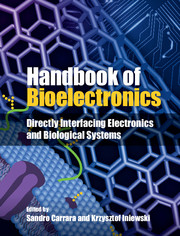Book contents
- Frontmatter
- Contents
- List of Contributors
- 1 What is bioelectronics?
- Part I Electronic components
- Part II Biosensors
- 8 Introduction to biosensors
- 9 CNT and proteins for bioelectronics in personalized medicine
- 10 CMOS nanowire biosensing systems
- 11 Cell-array biosensors
- 12 System-on-a-chip pulse radar for contactless motion sensing in human–machine smart interfaces
- 13 MagCMOS
- 14 Metamorphic neural interfaces with insects for remote controlled biobots
- Part III Fuel cells
- Part IV Biomimetic systems
- Part V Bionics
- Part VI Brain interfaces
- Part VII Lab-on-a-chip
- Part VIII Future perspectives
- Index
- References
10 - CMOS nanowire biosensing systems
from Part II - Biosensors
Published online by Cambridge University Press: 05 September 2015
- Frontmatter
- Contents
- List of Contributors
- 1 What is bioelectronics?
- Part I Electronic components
- Part II Biosensors
- 8 Introduction to biosensors
- 9 CNT and proteins for bioelectronics in personalized medicine
- 10 CMOS nanowire biosensing systems
- 11 Cell-array biosensors
- 12 System-on-a-chip pulse radar for contactless motion sensing in human–machine smart interfaces
- 13 MagCMOS
- 14 Metamorphic neural interfaces with insects for remote controlled biobots
- Part III Fuel cells
- Part IV Biomimetic systems
- Part V Bionics
- Part VI Brain interfaces
- Part VII Lab-on-a-chip
- Part VIII Future perspectives
- Index
- References
Summary
Introduction
Lowering the costs of healthcare and increasing its accessibility is a critical need of today’s society. Miniaturized electronic sensors are a possible way to both improve healthcare and lower the cost of medical diagnostics. Their small size and portability can lead to integration into personalized diagnostics tools and emergency care. In addition, faster, smaller and more efficient sensors can greatly impact chemical and biological safety.
The rapid progress demonstrated in the computer industry and in genomics is stirring interest for growth and applications in healthcare and safety. The relentless progress and developments in microfabrication predicted by Moore’s law, which forecast that the number of transistors on an integrated circuit would double every two years, has until now been continually producing faster, cheaper, and smaller consumer electronics. An analogous exponential growth in DNA sequencing is even faster than Moore’s law. Ten years ago, it would have taken many months to sequence a human genome. Today, the same task can be completed within one day. This impressive progress is possible owing to innovative applications of microfabrication technologies. If this can be applied to healthcare, it could stimulate a similar evolution, with applications such as early stage detection of biological infection outbreaks and chemical hazards, which could mitigate epidemics tremendously.
- Type
- Chapter
- Information
- Handbook of BioelectronicsDirectly Interfacing Electronics and Biological Systems, pp. 122 - 136Publisher: Cambridge University PressPrint publication year: 2015



